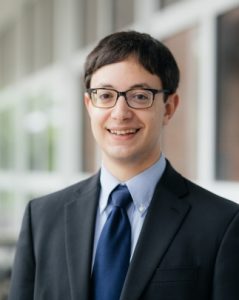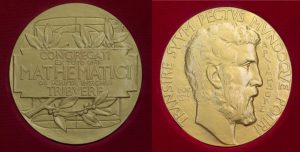A special thanks to Sarah Hayes, Grainger Engineering Library Graduate Assistant, for creating this Mathematics Library exhibit.
Behind the Scenes of Mathematicians’ Most Famous Prize, 1936-1966
Michael J. Barany (Dartmouth College)
On Tuesday, March 6, 2018 at 4:00 pm, in Altgeld Hall room 243, Barany will be discussing his article, “Fields Medal Confidential: Behind the scenes of mathematicians’ most famous prize, 1936-1966”. This is part of the Mathematics in Science and Society lecture series headed by the Department of Mathematics, a series of mathematic and scientific talks that has been running regularly since 1995.
Abstract: First presented in 1936, the Fields Medal quickly became one of mathematicians’ most prestigious, famous, and in some cases notorious prizes. Because its deliberations are confidential, we know very little about the early Fields Medals: how winners were selected, who else was considered, what values and priorities were debated—all these have remained locked in hidden correspondence. Until now. My talk will analyze newly discovered letters from the 1950 and 1958 Fields Medal committees, which I claim demand a significant change to our understanding of the first three decades of medals. I will show, in particular, that the award was not considered a prize for the very best mathematicians, or even for the very best young mathematicians. Debates from those years also shed new light on how the age limit of 40 came about, and what consequences this had for the Medal and for the mathematics profession. I argue that 1966 was the turning point that set the course for the Fields Medal’s more recent meaning.

About Michael J. Barany
Michael J. Barany is a postdoctoral fellow at Dartmouth College in the Society of Fellows and a historian of modern science and mathematics. He completed his Ph.D. in the History of Science in 2016 at Princeton University. Barany’s publications include articles in Notices of the American Mathematical Society, Nature, Scientific American, The New York Times, and several works in the Best Writing on Mathematics anthology series.

About the Fields Medal:
Since 1936, the Fields Medal has been awarded to the top mathematicians across the globe under the age of 40, and is awarded every four years at the meeting of the International Congress of the International Mathematical Union. Winners receive the titular medal as well as a prize award of $15,000 in Canadian dollars (almost $12,000 in USD). It is named after John Charles Field (1863-1932), a Canadian mathematician who is responsible for bringing the International Congress of the IMU to Toronto in the early 1900s and promoting the sciences in his home country.
Notable Fields Medal Winners:
- Lars Ahlfors (1907-1996) and Jesse Douglas (1987-1965), awarded in 1936 for their work on Riemann surfaces (Ahlfors) and solving the ‘Problem of Plateau’ in geometry. They are the first recipients of the Fields Medal.
- Jean-Pierre Serre (1926-current), awarded in 1954 for his work with the homotopy groups of spheres. He is the youngest winner of the Fields Medal to date, having won the award at the age of 27.
- Edward Witten (1951-current), awarded in 1990 for his work with general relativity and proof of the positive energy theorem. He is the first physicist to be awarded the Fields Medal.
- Maryam Mirzakhani (1977-2017), awarded in 2014 for her work on Riemann surfaces. She was the first woman and Iranian to win the Fields Medal, and was a professor of mathematics at Stanford University.
Items on display at the Mathematics Library:
Books:
The Best Writing on Mathematics 2015, edited by Mircea Pitici. Princeton, New Jersey, Princeton University Press, 2016.
Fields Medallists’ Lectures, edited by Michael Atiyah and Daniel Iagolnitzer. Singapore, World Scientific, 1997.
Modern Mathematics in the Light of the Fields Medals, Michael Monastyrsky. Wellesley, Mass., A.K. Peters, c1997.
Turbulent Times in Mathematics : the Life of J.C. Fields and the History of the Fields Medal, Elaine McKinnon Riehm, Frances Hoffman. Providence, R.I., American Mathematical Society, 2011.
Articles:
“God, king, and geometry: Revisiting the introduction to Cauchy’s Cours d’analyse”, Michael J. Barany, Historia Mathematica, Volume 38, Issue 3, August 2011.
“Spectral operators on the Sierpinski gasket I”, Adam Allan, Michael J. Barany, and Robert S. Strichartz, Complex Variables and Elliptic Equations, Volume 54, Issue 6, 2009.
“The world war II origins of mathematics awareness”, Michael J. Barany, Notices of the American Mathematical Society, Volume 64, Issue 4, 2017.